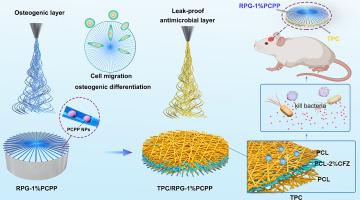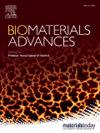用于颅底重建的具有防漏、抗菌和成骨整合功能的 Janus 径向纳米纤维贴片
IF 5.5
2区 医学
Q2 MATERIALS SCIENCE, BIOMATERIALS
Materials Science & Engineering C-Materials for Biological Applications
Pub Date : 2024-11-19
DOI:10.1016/j.bioadv.2024.214122
引用次数: 0
摘要
在经蝶窦手术切除垂体腺瘤的过程中,由硬脑膜和颅底骨组成的颅底结构遭到破坏,因此恢复颅底的自然结构至关重要。我们利用逐层电纺技术制作了双层 Janus 纤维膜,包括成骨细胞层和防漏抗菌层。具体来说,RPG-1%PCPP径向排列的纳米纤维膜(成骨细胞)可促进细胞定向迁移,促进细胞成骨分化。TPC 纳米纤维膜(防漏抗菌层)可防止液体渗漏,同时释放抗菌剂以抵抗细菌感染。抑菌测试表明,头孢唑啉对大肠杆菌和金黄色葡萄球菌都有很好的抑制能力。RT-PCR 试验表明,载入 PCPP 的径向纤维膜可促进 ALP 和 BMP-2 基因的表达,从而促进细胞的成骨分化。动物实验表明,TPC/RPG-1%PCPP纤维膜组的BV/TV明显高于空白组,表明TPC/RPG-1%PCPP可促进骨组织再生。本文章由计算机程序翻译,如有差异,请以英文原文为准。

Janus radial nanofiber patch with leak-proof, antimicrobial, and osteogenic integration for skull base reconstruction
During transsphenoidal surgery to remove pituitary adenomas, the structures of the skull base consisting of the dura mater and skull base bones are destroyed, making it crucial to restore the natural structure of the skull base. We crafted a dual-layer Janus fiber membrane utilizing the layer-by-layer electrospinning technique, comprising an osteoblast layer and a leak-proof antimicrobial layer. Specifically, RPG-1%PCPP radially aligned nanofibrous membranes (osteoblasts) can promote directional cell migration and facilitate cellular osteogenic differentiation. TPC nanofibrous membranes (leak-proof antimicrobial layer) can prevent fluid leakage while releasing antimicrobials for resisting bacterial infections. Bacteriostatic tests showed that cefazolin had a good inhibitory ability against both E. coli and S. aureus. RT-PCR showed that radial fiber membrane loaded with PCPP promoted the expression of ALP and BMP-2 genes, thereby promoting osteogenic differentiation of cells. Animal experiments showed that the BV/TV in the TPC/RPG-1%PCPP fiber membrane group was significantly higher than that in the blank group, indicating that TPC/RPG-1%PCPP could promote bone tissue regeneration.
求助全文
通过发布文献求助,成功后即可免费获取论文全文。
去求助
来源期刊
CiteScore
17.80
自引率
0.00%
发文量
501
审稿时长
27 days
期刊介绍:
Biomaterials Advances, previously known as Materials Science and Engineering: C-Materials for Biological Applications (P-ISSN: 0928-4931, E-ISSN: 1873-0191). Includes topics at the interface of the biomedical sciences and materials engineering. These topics include:
• Bioinspired and biomimetic materials for medical applications
• Materials of biological origin for medical applications
• Materials for "active" medical applications
• Self-assembling and self-healing materials for medical applications
• "Smart" (i.e., stimulus-response) materials for medical applications
• Ceramic, metallic, polymeric, and composite materials for medical applications
• Materials for in vivo sensing
• Materials for in vivo imaging
• Materials for delivery of pharmacologic agents and vaccines
• Novel approaches for characterizing and modeling materials for medical applications
Manuscripts on biological topics without a materials science component, or manuscripts on materials science without biological applications, will not be considered for publication in Materials Science and Engineering C. New submissions are first assessed for language, scope and originality (plagiarism check) and can be desk rejected before review if they need English language improvements, are out of scope or present excessive duplication with published sources.
Biomaterials Advances sits within Elsevier''s biomaterials science portfolio alongside Biomaterials, Materials Today Bio and Biomaterials and Biosystems. As part of the broader Materials Today family, Biomaterials Advances offers authors rigorous peer review, rapid decisions, and high visibility. We look forward to receiving your submissions!

 求助内容:
求助内容: 应助结果提醒方式:
应助结果提醒方式:


